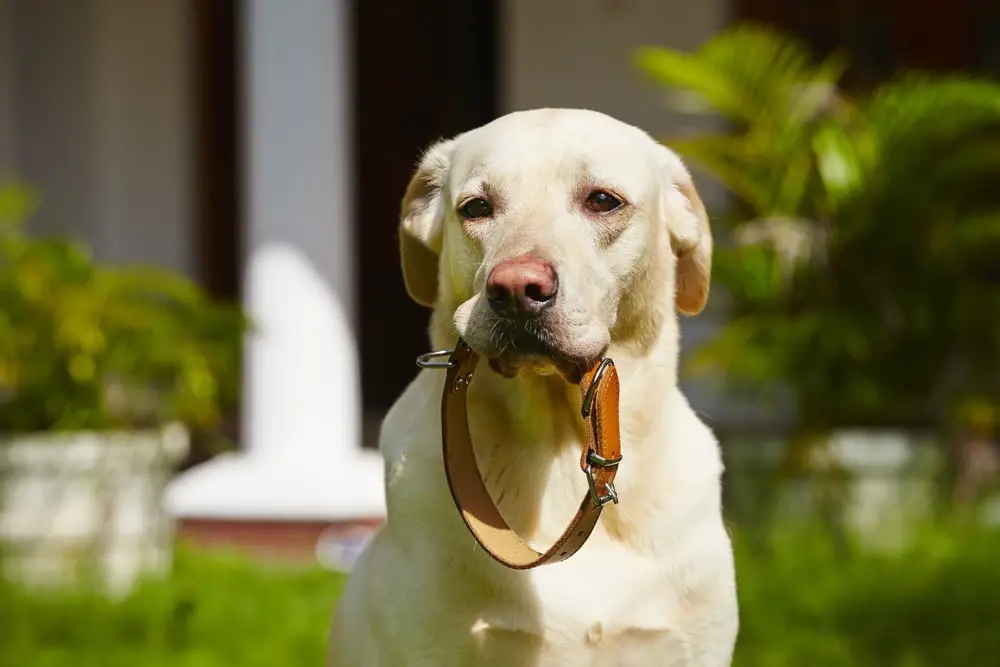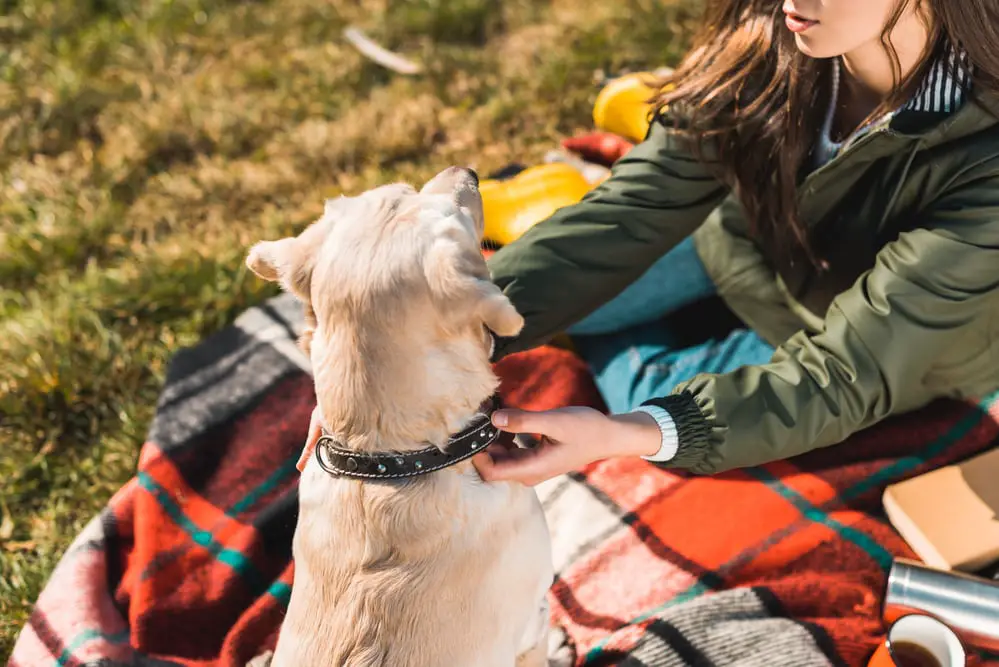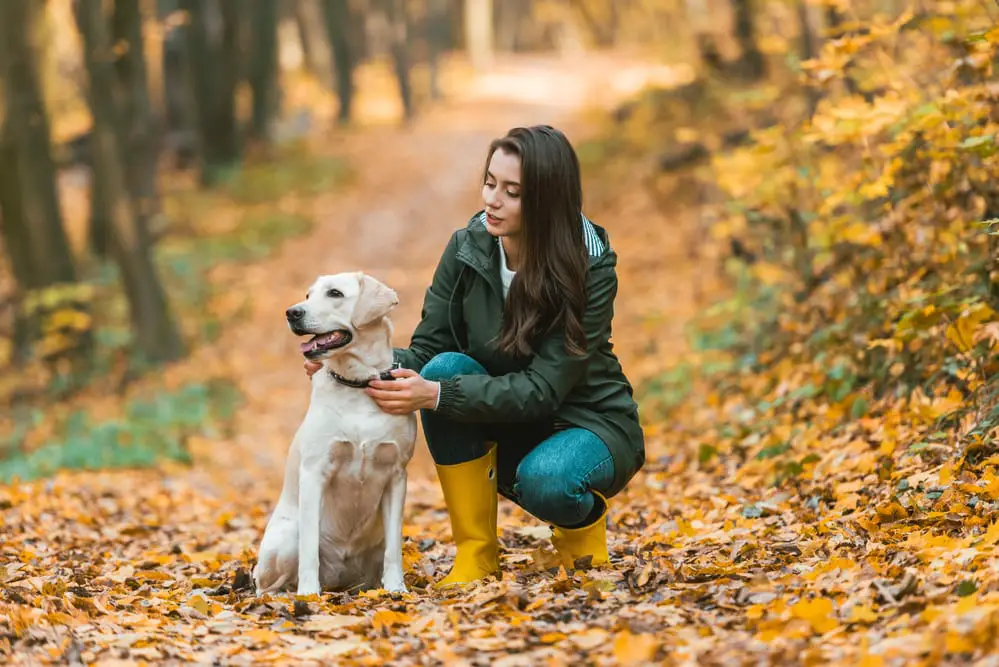Allergies in dogs are on the rise. With all the chemicals used in the manufacturing of collars, harnesses, and leashes, our dogs have begun to develop sensitivities. So what is the best collar for dogs with a sensitive neck?
Choosing the right collar for your best friend can be a daunting task. Before selecting a pattern or color, the first thing to consider is the material that will give the most comfort to your dog. You may not know at first if the makeup of the material will cause your dog discomfort, so it is usually best to start with nylon, leather, or a natural fiber such as bamboo or hemp.
Materials used for Dog Collars

Synthetic Materials
Faux leather or pleather is composed of fabric such as polyester, which is very inexpensive. To give it the look and texture of leather, the manufacturer applies a coat of wax, dye, polyvinyl chloride (PVC), or polyurethane. The chemicals used to make the collar are all potential irritants to a sensitive neck.
Biothane, unlike faux leather, is made from a polyester webbing and powder coated with either polyvinyl or polyurethane. The collars are soft, flexible, waterproof, affordable, and come in a wide array of patterns and colors.
They are also easy to clean and, unlike faux leather, are non-toxic but could irritate a sensitive neck.
Nylon and Nylon blends are the most common type of collars. There is an endless variety of patterns, styles, and designs to please individuals from the fun-loving to the fashionista.
The collars are durable, strong, and good for the puddle-loving pup. They are also generally easy to clean with mild soap and water. Dish soap works well on any embedded grime. Just let the collar soak for about ten minutes, rinse, and dry thoroughly.
Nylon allergies are rare. If your dog develops sensitivity to their nylon collar, the nylon is not the problem. Chemicals, dyes, and protectants are applied during the manufacturing process. The chemicals are what cause the reaction.
Carpeting, toys, fishing line, among others, all contain nylon. Removing all objects containing nylon from your dog’s environment will be necessary (source).
Neoprene is an excellent choice if your dog loves the water. It dries quickly, keeping moisture off the dog’s neck. It is woven with nylon webbing, adding to the collar’s stretch, durability, and strength.
However, it does tend toward a higher price point. It also lacks many of the style choices of nylon and nylon blends. A key advantage of neoprene is that it’s a good choice for sensitive necks.
Natural Materials
Hemp is a natural fiber from plants. It is a strong fiber, naturally hypoallergenic, and water-friendly. If your dog has sensitive skin, an allergy, or is prone to hot spots, hemp is a good alternative. To clean it, just throw it in the washer with a mild detergent. It will come out better each time and never lose its shape.
Leather is a very elegant material that is also durable. It is breathable and excellent for dogs with sensitive necks. It is easy to clean and becomes softer over time. It may be expensive, but it is an investment that will last for years (source).
Bonded leather is not as strong as regular leather due to the manufacturing process used. Many strips of leather are joined and then held together with a bonding agent. The resulting product looks and feels like its leather counterpart, but it will result in disappointment.
Bamboo is a wonderful choice for sensitive necks and the earth-conscience pet owner. Bamboo is a sustainable plant that absorbs carbon in the air around it and produces more oxygen than most plants and trees.
Because the roots are left when harvested, bamboo grows quickly and is in abundant supply. The fibers are strong, flexible, non-toxic, and hypoallergenic. Bamboo collars also come in varying colors and designs at an affordable price (source).
Chain collars, also known as choke collars, are made from a variety of metals, including nickel-plated, brass, chrome-plated, and silver, which are potential irritants.
Choke collars can be useful for aggressive dogs that are harder to discipline or do not respond well to scolding.
This collar has the potential to severely damage the trachea, as it is designed as a training tool, making it a poor choice for everyday wear. Take careful consideration and consult your veterinarian before use.
Other Considerations
Other factors to take into consideration include the width of the collar, whether it’s padded or not padded, what your dog will be doing while wearing the collar, and how well-behaved your dog is, as well as the collar’s material and style,
Collar Style
There are five types of collars: standard, chain, martingale, LED, and waterproof. Which one you choose depends upon what you and your dog will be doing.
A standard collar is perfect for everyday use and the dog that is easy to walk. If your dog tends to pull on the leash, a chain or martingale collar would be the best choice.
A chain collar will pull tight against the dog’s neck if the dog pulls, causing pressure on the trachea.
A martingale collar works the same way. It tightens around the dog’s neck but, unlike a chain or choke collar, it does not pull tight enough around their neck to cause harm.
Padded collars are also a wonderful alternative for sensitive dogs. The collar has thick padding that helps prevent the collar from rubbing against the dog’s neck and forming sores.
When the collar is attached to the leash and the dog pulls, the padding will distribute the pressure across the whole neck, preventing injuries.
Do you walk at night or before the sun comes up in the morning? If so, you may want an LED collar. The LED collar is made with either a flashing or steady light built-in and may also be reflective.
A waterproof collar is perfect for the dog that loves water or lives in a damp climate. Standard and martingale collars are both available with the LED or waterproof feature.
How to Correctly Size the Collar
The width of the collar is an important component in your dog’s comfort. To accurately size the collar, you must first measure your dog’s neck.
Using a cloth measuring tape, place it around their ears and collar bone, and then add two inches. When adjusting the collar, the general rule of thumb is to be sure you can fit two fingers between their neck and collar.
There are some mistakes that we might overlook about dog collars, see video below:
A Collar includes More than the Strap Material
If your dog has a sensitive neck, pay attention to the way the collar closes. Does it slip over the dogs’ head, or does it have a metal or plastic buckle?
The fastener, especially if made of metal, could be the source of the allergy and not the collar material.
Strength and durability are an integral part of the search for the perfect collar. If you have a very energetic dog, a plain plastic buckle may not hold.
You could opt for one reinforced with aluminum. Buckles made with only metal are very strong but not the best choice for a dog with a sensitive neck.
Round or Flat?
Round collars, made from leather and bonded leather, are an alternative to the traditional flat collar style. Rounding the collar prevents the dog’s fur from matting.
However, the stitching can be irritating. While a good choice for long-haired breeds, the rounded style is prone to stretching and eventually breaking. If your dog pulls, it is not a good choice.
How Do You Know if Your Dog is Allergic to Their Collar?

Like humans, dogs have allergies. As defined in Medical News Today, “allergies are hypersensitive responses from the immune system to substances that either enter or have contact with the body. A substance that causes an allergic reaction is called an allergen”.
According to Drs. Barnette and Ward, allergies are very common in dogs. Contact dermatitis is the easiest to diagnose because the symptoms are physical.
There are two types of contact dermatitis: allergic contact dermatitis and irritant contact dermatitis.
Allergic contact dermatitis, as described by Mike Clark in DogTime, happens when “the immune system overreacts to a normally harmless substance, causing inflammation”. The reason is often due to seasonal allergies.
Irritant contact dermatitis happens “when a substance directly damages the skin” such as chemicals, synthetic materials, plants, or natural fibers (source). Like allergic contact dermatitis, Inflammation also occurs.
Symptoms
The symptoms of contact dermatitis, whether allergic or irritant, will show up on your dog’s skin. You may notice your dog excessively scratching the spot of contact.
Their scratching will lead to soreness and wounds such as blisters, ulcers, and even a change in skin color. It can also affect other areas of the body that may have contact, such as their paws.
The skin of the affected area may become dry, thick, and scaly, setting up an itch-heal-itch cycle. Wounds such as scratches, ulcers, or lesions may show signs of inflammation or swelling.
Another possibility is that a discharge could begin to ooze from the wound. Any open wound, especially if it is weeping, is a concern as your dog may have contracted a bacterial infection.
Alopecia, a partial or complete loss of fur, is another symptom of irritant contact dermatitis. Alopecia causes bald patches and affects more than your dog’s skin. Alopecia also affects the endocrine, lymphatic, and immune systems (source).
Common Irritants that Maybe the Root of Contact Dermatitis
There are so many substances your dog can have contact with on any given day. There are obvious substances that come to mind, such as plants or bug bites, as well as what material their collar comes from, such as nylon, neoprene, metal, bamboo, etc.
Many items around your home that are also potential irritants include household cleaners, mulch, fertilized grass, soap or shampoo, makeup, and creams or lotions.
Other less likely culprits may be medications, especially topical. The sun or heat may cause your dog to scratch and create wounds. Any infection, be it parasitic, bacterial, or fungal, can be a cause or a result of contact dermatitis.
Some dogs love to rub their heads against the carpet. Most carpets fibers are a blend of nylon and other synthetic fibers or wool.
Your dog’s blankets, bed, or outfits you may put on them could all contribute to or be the main problem. Harnesses and leashes are also irritants, especially if they match the collar material.
The Treatment of Contact Dermatitis
While you might be tempted with natural remedies, many of which you may already have at hand, it is a good idea first to consult your vet.
Natural remedies, while preferable for many dog owners, may cause more harm than good. What might be safe and effective for humans may not be so for dogs?
The Diagnosis
To avoid worsening their symptoms, you must first know what is at the root of your dog’s symptoms.
The symptoms of both allergic and irritant contact dermatitis mimic symptoms of a myriad of other diseases such as lupus.
Of course, it could just be dandruff, which is annoying but easily treated. On the other hand, there are underlying diseases that cause dermatitis. Irreparable damage could be done to your dog if their symptoms are left untreated.
Once the vet has ruled out other causes and is confident that the problem is contact dermatitis, they will perform a cytologic analysis and a skin scraping.
The vet will take a small sample of the area and send it out to a laboratory for evaluation. Once the vet knows the cause of the symptoms, they will then be able to proceed with appropriate treatment.
The Treatment Regimen
The first treatment will consist of thoroughly washing the irritant off your dog’s skin and fur.
As shampoos can also be irritating to the skin, your vet will recommend what wash or shampoo to use. Some washes and shampoos contain antihistamines, which are useful to deliver immediate relief.
If your dog has a severe reaction, the vet will prescribe oral antihistamines, corticoid steroids, or cyclosporine. Any of these drugs are used to treat inflammation and swelling.
If a bacterial or fungal infection is present, the vet will prescribe antibiotics. If the dog does not respond to these treatments, the vet will recommend corticosteroid injections.
Problems with Flea Collars
Another cause of irritant and allergic contact dermatitis is the flea collar. Flea collars thought to be perfectly safe and innocuous and have been around for years.
Unfortunately, the chemical which kills off the fleas causes a reaction in some dogs.
If your dog is allergic or sensitive to flea collars, there are alternative preventative medications.
Topical treatments such as Frontline, which you apply on a small spot of the skin, could be a good solution. To keep the chemical off the skin entirely, your vet may prescribe an oral treatment such as Nexguard.
What is Collar Maintenance, and is it Necessary?

Once you have chosen the perfect collar for your dog, proper care of the collar will ensure the most comfort for your dog and longer life from the collar.
Clean your dog’s collar often. Soak it in the sink in a mild detergent, such as blue Dawn, or take a soft cloth with soap and wipe it down. Blue Dawn is a safe product for your dog. It not only takes out grimy grease and dirt, but it also kills fleas.
The shampoo you use to bathe your dog is the perfect cleanser. You know your dog tolerates the shampoo, so you can’t go wrong. Even easier, some collars are machine washable.
The size of your dog’s neck changes over time, from puppy through senior. When you wash material, it also changes; it may shrink or stretch. Check the fit periodically. If it’s too tight, it could cause chafing and irritation. If it is too loose, your dog could slip out of it and get lost.
When you clean your dog’s collar, you are not just making it look nice. You are also washing away harmful bacteria that build up and cause sensitivity, allergy, or infection.
Proper maintenance is not only good for your dog’s health, but it will also be easier on your budget in the long run.
**Got dogs that are eating your carpet? Read this guide on what to do about it here!**
Final Thoughts
So what collar is best for dogs with sensitive necks? You and your vet are the only ones qualified to answer this question.
Finding the best collar for your dog might be hit or miss at first. If necessary, consult your vet. They will expertly guide you through the process and help narrow down the options
The pet store is another place you can go for advice. The associates will help you with any questions you may have. When going to a pet store, bring your dog shopping with you.
Not only can you measure their neck right at the store, but you can pick out the pattern and color that best matches your dog’s fur color and personality.
Whatever collar you choose, if your dog is happy and comfortable you will both enjoy many happy and irritant-free years.


0 Comments